Cardinalidae
| Cardinalids | |
|---|---|

| |
| Male breeding dickcissel (Spiza americana). | |

| |
| Male northern cardinal (Cardinalis cardinalis). | |
| Scientific classification | |
| Domain: | Eukaryota |
| Kingdom: | Animalia |
| Phylum: | Chordata |
| Class: | Aves |
| Order: | Passeriformes |
| Superfamily: | Emberizoidea |
| Family: | Cardinalidae Ridgway, 1901 |
| Type species | |
| Loxia cardinalis | |
| Genera | |
|
Pheucticus | |
Cardinalidae (sometimes referred to as the "cardinal-grosbeaks" or simply the "cardinals") is a family of New World-endemic passerine birds that consists of cardinals, grosbeaks, and buntings. It also includes several other genera such as the tanager-like Piranga and the warbler-like Granatellus. Membership of this family is not easily defined by a single or even a set of physical characteristics, but instead by molecular work. Among songbirds, they range from average-sized to relatively large, and have stout features, some species with large, heavy bills.
Members of this group are beloved for their brilliant red, yellow, or blue plumages seen in many of the breeding males in this family. Most species are monogamous breeders that nest in open-cup nests, with parents taking turns incubating the nest and taking care of their young. Most are arboreal species, although the dickcissel is a ground-dwelling prairie bird.
In terms of conservation, most members of this family are considered least concern by the IUCN Red List, though a few birds, such as the Carrizal seedeater, are considered to be endangered.
Field characteristics
[edit]The grosbeaks, seedeaters, and cardinals have large bills, while Granatellus and buntings have small bills. The cardinalid tanagers have stout, near pointed bills, with some species of Piranga having serrations along the edge of their upper bills.[1] This bill shape is not always an indicator of relationships, as the various species of blue cardinalid species, like the blue grosbeak and Cyanoloxia grosbeaks are related to the buntings. Similarly, the cardinalid tanagers are closer to the cardinals and masked grosbeaks (see more in the systematics section). The head is medium to large in size, with a medium neck length. The body of cardinalids ranges from small to medium with lengths of 4.5 to 11 in (11 to 28 cm). Legs are also short to medium in length. The wings are medium and pointed. Cardinalids have nine visible primary feathers with the tenth primary feather being short in comparison.[2][3][4]
The plumages in cardinalids are sexually dichromatic as many males of various species display bright reds, oranges, blues or blacks. In most temperate species, males will undergo molting between seasons, so that non-breeding males will somewhat resemble the females of their species. These species, such as the indigo bunting, will exhibit a complex molt cycle going through four different stages of plumage coverage within their first year of life. From spring to summer, birds start with juvenile plumage to supplemental plumage, then changing to a first basic (nonbreeding) plumage from fall to winter, and finally reaching the first alternate (breeding) plumage. Adults will typically have the basic two molt cycle changing to basic or partial in the late summer or fall, and then back to alternate again in the spring. Males of tropical species will have the same coloration year-round. Females of all species are either drabber in coloration by comparison, often having a lighter coloration of the males. The molting pattern in most cardinalids exhibits delayed plumage maturation, causing the first-year male birds to often be in non-breeding plumage or at an intermediate stage.[2] The molting pattern in cardinalids is divided into two types. A preformative molt is a partial molt where only the body feathers get replaced, but not the wing and tail feathers, which is seen in a lot of temperate and neotropical species. The second type is an eccentric preformative molt when only the outer primary and inner secondaries are replaced. This molt is seen in some species of Cyanoloxia and Passerina.[5][6]
Systematics
[edit]Traditionally, members of this group were classified as a tribe of the finch family Fringillidae (Cardinalini), characterized by heavy, conical, seed-crushing bills. The group consisted of the genera Pheucticus, Parkerthraustes, Saltator, Spiza, Cyanocompsa, Cyanoloxia, Porphyrospiza, Passerina, Caryothraustes, Periporphyrus, and Cardinalis. The issue that taxonomists had faced was that there were no unifying morphological traits that were in agreement for various studies.[7] In 2007, a mitochondrial DNA study by Klicka, Burns and Spellman sampling all of the aforementioned genera and 34 of the total 42 species, found that the genera Parkerthraustes, Saltator, and Porphyrospiza were not members of the cardinal-lineage, but instead are found throughout in the tanager-lineage (Thraupidae). The genera classified as thraupids at the time, Piranga, Habia, Chlorothraupis, and Amaurospiza, are found to be part of cardinalid radiation. In addition the genus Granatellus, originally classified as a parulid warbler, are also found to be part of Cardinalidae.[8] The study found that with this new relationship Cardinalidae can be classified into five subgroups, which have been supported by subsequent studies. The five subclades consists of the Habia lineage (Habia and Chlorothraupis), the “masked” lineage (Piranga, Caryothraustes, Periporphyrus, Rhodothraupis, and Cardinalis), the Granatellus lineage, the “blue” lineage (Cyanocompsa, Amaurospiza, Cyanoloxia, Passerina, and Spiza), and the Pheucticus lineage.[8] These subclades and membership of these genera have been widely supported in subsequent studies.[9][10] A 2021 paper by Guallar et al. based on the preformative molting pattern of cardinalids suggested the ancestor of this group was a forest-dwelling bird that dispersed into open habitats on numerous occasions.[6]
The cardinalids are part of a larger grouping of American endemic songbirds, Emberizoidea, which also includes the aforementioned thraupids and parulids, as well as icterids (New World blackbirds), passerellids (New World sparrows), and several families that contain one or a couple of genera. Several studies have placed cardinalids as either the sister group to Thraupidae,[9] Mitrospingidae (a small family whose genera were formerly classified as thraupids),[11] or the sister to a clade containing thraupids and mitrospingids.[10] At least one study suggested that cardinalids could treated as a subfamily of Thraupidae.[12]
Phylogeny
[edit]The genus level cladogram of the Cardinalidae shown below is based on molecular phylogenetic study published in 2024 that analysed DNA sequences flanking ultraconserved elements (UCEs).[13] The number of species in each genus is taken from the list maintained by Frank Gill, Pamela C. Rasmussen and David Donsker on behalf of the International Ornithological Committee (IOC).[14]
| Cardinalidae |
| ||||||||||||||||||||||||||||||||||||||||||||||||||||||||||||||||||||||||
Species list
[edit]The following 53 species and 14 genera are recognized by the IOC as of July 2024:[14]
| Image | Genus | Living species |
|---|---|---|
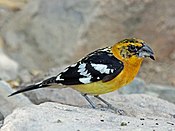 |
Pheucticus L. Reichenbach, 1850 |
|
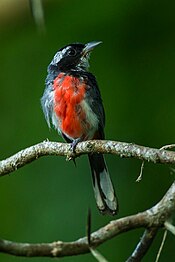 |
Granatellus Bonaparte, 1850 |
|
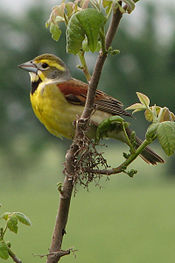 |
Spiza Bonaparte, 1824 |
|
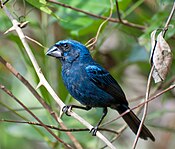 |
Cyanoloxia Bonaparte, 1850 |
|
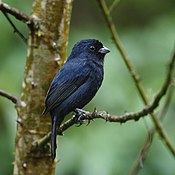 |
Amaurospiza Cabanis, 1861 |
|
 |
Cyanocompsa Cabanas, 1861 |
|
 |
Passerina Vieillot, 1816 North American buntings |
|
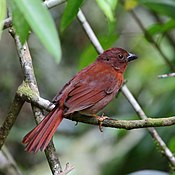 |
Habia Blyth, 1840 |
|
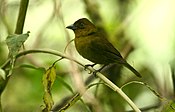 |
Chlorothraupis Salvin & Godman, 1883 |
|
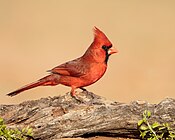 |
Cardinalis Bonaparte, 1838 |
|
 |
Caryothraustes L. Reichenbach, 1850 |
|
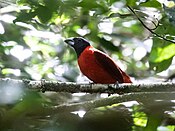 |
Periporphyrus L. Reichenbach, 1850 |
|
 |
Driophlox Scott, BF, Chesser, Unitt & Burns, KJ, 2024 |
|
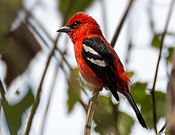 |
Piranga Vieillot, 1808 |
|
Natural history
[edit]Habitat, distribution and migration
[edit]The cardinalids can be found from Canada to northern Argentina and Uruguay, with Central America having the most concentrated amount of species. Species are found year-around in the Central United States and the Eastern United States down to the neotropics. Cardinalids found in the West Indies are non-breeding migrants and those in the Western United States and Canada are breeding migrants.[3] The western tanager is the northernmost species in the family, with their breeding ranges occurring in the southern portions of the Northwest Territories. The northern cardinal has been introduced in Hawaii and Bermuda. They occupy a variety of habitats from forests to grassland and arid scrubland. Most North American cardinalid species migrate south for the winter, whether further south in the continent or extending into the neotropics, except the northern cardinal and pyrrhuloxia which stay year-round. The neotropical species are residential year-round in their range.[2]
Feeding ecology
[edit]
Cardinals, the dickcissel, seedeaters, buntings, and grosbeaks have the thicker, seed-crushing bills that enabled them to feed heavily on fruits and seeds outside of the breeding season (especially in the winter for northern species like the aforementioned dickcissel and northern cardinal). Once their breeding season begins, members of this group will supplement themselves with invertebrate prey, vital when raising their young and refueling their energetic costs of reproduction and other daily activities. The genera Chlorothraupis, Habia, Piranga, and Granatellus have slightly longer and less deep bills, which their diet mostly consists of insects, fruit, nectar and sap, less so on seeds.[4] Cardinalids typically forage alone low level or on the ground, though some like Piranga and grosbeaks will forage high in the tree canopy. Many will come to birdfeeders especially during the winter.[2]
Breeding and reproduction
[edit]
Nearly all cardinalids are monogamous breeders and are highly territorial. Despite being monogamous this is only during the breeding season, and each year the birds might partner up with a different bird. The only exception is the dickcissel which is a polygynous species which nest in dense grasses and sedges. Other non-monogamous species include the lazuli and painted buntings which perform extra-copulation with multiple partners. The family is known for their intense brilliant songs. In some species like the lazuli bunting and indigo bunting the bird learn singing by match-based, meaning that first year breeding males will learn by copying the songs of nearby males, as opposed of learning it while they are in the nest. Even more unusual is the females of a few species, such as the scarlet tanager,[1] northern cardinal, pyrrhuloxia, and black-headed grosbeak, which sing as well. In temperate species the breeding season occurs annually while in tropical species it is year-around. The breeding seasons is in sync with the abundance of insects. Most species build open-cup nests made of grasses and twigs depending on the species. These nests would be in the trees, often high up in the crown. The nest building is done by both partners or by the female alone. The male and female take turns incubating the nest, often the male would feed the female.[2] In a clutch on average there are 1 to 6 six eggs, with tropical species laying the fewest.[15] Cardinalids produce one to three broods per season. As with other passerines, the young are born altricial and fledged between one and two weeks.[15]
Conservation
[edit]
As of 2021, the IUCN Red List has nearly 82 percent of cardinalids to be least concern. However, there are a handful of species that are of conservation concern. The rose-bellied bunting is an endemic near-threatened species as they are found in a small area of Oaxaca and Chiapas, Mexico; the black-cheeked ant-tanager is another endemic species found in Osa Peninsula in Costa Rica and the carrizal seedeater a critically endangered species found in the spiny bamboo thickets in the understory of deciduous forest in a remote southeastern corner of Venezuela. All of these species are threatened with habitat loss and the confinement within their much smaller range. The IUCN has not yet reevaluate the other species of seedeaters in the genus Amaurospiza.[4]
Despite the vast majority of species being classified as least concern, there has been a growing concern in how the ongoing climate crisis will affect the distribution and migration of many species across the globe. One study led by Dr. Brooke L. Bateman published in July 2020 focused on the risk North American birds will face from climate change and the measures needed to protect them. The first study assessed 604 species from the United States found that if the planet warmed by 3.0 degrees Celsius many species, especially arctic birds, waterbirds, and boreal and western forest birds, will be highly vulnerable to climate change and future conservation efforts will need to be in place.[16] Among the species sampled, the North American species of Piranga and Pheucticus are found to be most climate vulnerable of the cardinalids.[17] These species will either lose some substantial amount of their range or they will migrate up north to escape the sudden change in their habitat.
A possible extinct species is the controversial Townsend's bunting, a supposed enigmatic species related to the dickcissel. The Townsend's bunting is only known from a single type specimen collected from Chester County, Pennsylvania by John Kirk Townsend and described by John James Audubon in 1834. The specimen is housed in the National Museum of Natural History. Genetic work has not been done on this bird, but observation of the plumage has been done. The controversy stems from the uncertainty from authors whether the bird is an extinct species, a rare color-variant of the dickcissel, or a hybrid female dickcissel and male blue grosbeak. If the bird is indeed simply a dickcissel it lacks any of the known field characteristics seen in the species in all life stages and sexes.[18]
References
[edit]- ^ a b Wells, A. C.; Wells, J. V. (2001). "Tanagers". In Sibley, D.; Elphick, C.; Dunning, J. B. Jr. (eds.). The Sibley Guide to Bird Life & Behavior. New York City: Alfred A. Knopf, Inc. pp. 512–515. ISBN 1400043867.
- ^ a b c d e Thompson, C. W. (2001). "Cardinals and Allies". In Sibley, D.; Elphick, C.; Dunning, J. B. Jr. (eds.). The Sibley Guide to Bird Life & Behavior. New York City: Alfred A. Knopf, Inc. pp. 536–541. ISBN 1400043867.
- ^ a b Dunne, P.; Karlson, K. T. (2021). Bird Families of North America. Location: Mariner Books. pp. 1–288. ISBN 978-0358164074.
- ^ a b c Winkler, D. W.; Billerman, S. M.; Lovette, I. J. (4 March 2020). "Cardinals and Allies (Cardinalidae), version 1.0". Birds of the World. doi:10.2173/bow.cardin1.01. S2CID 216193779. Retrieved 7 January 2022.
- ^ Guallar, S.; Rueda-Hernández, R.; Pyle, P. (2020). "Preformative molt in Neotropical Cardinalidae". Ornithology Research. 28 (4): 250–257. doi:10.1007/s43388-020-00024-z. hdl:2072/377740. S2CID 228930759.
- ^ a b Guallar, S.; Rueda-Hernández, R.; Pyle, P. (2021). "Evolution of the preformative molt in Cardinalidae correlates with transitions from forest to open habitats". The Auk. 138 (1). doi:10.1093/ornithology/ukaa070.
- ^ Hellack, J. J.; Schnell, G. D. (1977). "Phenetic analysis of the subfamily Cardinalinae using external and skeletal characters". The Wilson Bulletin. 89 (1): 130–148. JSTOR 4160878.
- ^ a b Klicka, J.; Burns, K.; Spellman, G. M. (2007). "Defining a monophyletic Cardinalini: a molecular perspective". Molecular Phylogenetics and Evolution. 45 (3): 1014–1032. doi:10.1016/j.ympev.2007.07.006. PMID 17920298.
- ^ a b Barker, F. K.; Burns, K. J.; Klicka, J.; Lanyon, S. M.; Lanyon, I. J. (2014). "New insights into New World biogeography: An integrated view from the phylogeny of blackbirds, cardinals, sparrows, tanagers, warblers, and allies". The Auk: Ornithological Advances. 132 (2): 333–348. doi:10.1642/AUK-14-110.1. S2CID 53058340.
- ^ a b Oliveros, C.H.; et al. (2019). "Earth history and the passerine superradiation". Proceedings of the National Academy of Sciences of the United States. 116 (16): 7916–7925. doi:10.1073/pnas.1813206116. PMC 6475423. PMID 30936315.
- ^ Barker, F. Keith; Burns, Kevin J.; Klicka, John; Lanyon, Scott M.; Lovette, Irby J. (2013). "Going to extremes: contrasting rates of diversification in a recent radiation of New World passerine birds". Systematic Biology. 62 (2): 298–320. doi:10.1093/sysbio/sys094. PMID 23229025.
- ^ Selvatti, A. P.; Gonzaga, L. P.; de Moraes Russo, C. A. (2015). "A Paleogene origin for crown passerines and the diversification of the Oscines in the New World". Molecular Phylogenetics and Evolution. 88: 1–15. doi:10.1016/j.ympev.2015.03.018. PMID 25837731.
- ^ Scott, B.F. (2022). Phylogenetics of Cardinalidae and the impact of habitat, climate, and ecology on the evolution of color (MSc thesis). San Diego State University.
- ^ a b Gill, Frank; Donsker, David; Rasmussen, Pamela, eds. (July 2024). "Cardinals, grosbeaks and 'tanager' allies". IOC World Bird List Version 14.2. International Ornithologists' Union. Retrieved 24 October 2024.
- ^ a b Dittman, D. L.; Cardiff, C. W. (2009). "Grosbeaks and Allies". In Harris, T. (ed.). National Geographic Complete Birds of the World. Washington, D.C.: National Geographic. pp. 362–363. ISBN 9781426204036.
- ^ Bateman, B. L.; Wilsey, C.; Taylor, L.; Wu, J.; LeBaron, G. S.; Langham, G. (2020). "North American birds require mitigation and adaptation to reduce vulnerability to climate change". Conservation Science and Practice. 2 (8). doi:10.1111/csp2.242. S2CID 225453243.
- ^ Waters, H. (10 October 2019). "The Future for Birds". Audubon. Retrieved 7 January 2022.
- ^ Hume, J. P. (2017). Extinct Birds. London: Bloomsbury Publishing. pp. 1–560. ISBN 9781472937469.
External links
[edit]- Cardinalidae videos, photos and sounds on the Internet Bird Collection
- Cardinalidae sounds on xeno-canto.org
- Northern cardinal (bird information) on petinfospot.com
- Northern cardinal, including sound and video clips, on Cornell Lab of Ornithology


